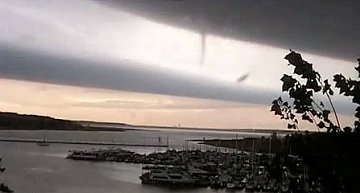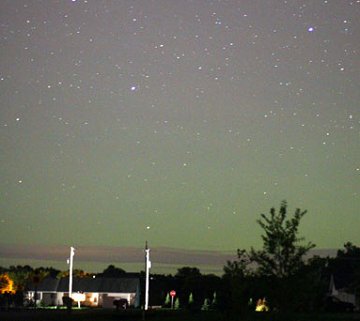 Where's Saturn? Is that a UFO--or the ISS? What's the name of that star? Get the answers from mySKY--a fun new astronomy helper from Meade. . Where's Saturn? Is that a UFO--or the ISS? What's the name of that star? Get the answers from mySKY--a fun new astronomy helper from Meade. . CELESTIAL TRIANGLE: Set your alarm. For the next four mornings, just before dawn banishes the night, you can see a fantastic celestial triangle rising in the eastern sky. The corners are Venus, Saturn and the bright star Regulus. This is worth waking up for! Sky maps: Oct 12, 13, 14, 15 GIANT WAVES OVER IOWA: On October 3rd, a train of giant waves rippled across the skies of Des Moines, Iowa, in view of Iowa Environmental Mesonet video cameras. Click on the image below to play the movie: 
Movies: 5 MB mov, 5 MB gif, 13 MB gif.
This is a special kind of atmospheric gravity wave called an "undular bore." Researchers believe undular bores may be more common and more important then previously thought. Among the things they can do: collide with tornados and spin them up, turning ordinary twisters into F5 monsters. "An undular bore passes over any given point in the United States about once a month," estimates Tim Coleman of the National Space Science and Technology Center in Huntsville, Alabama. Read today's story from Science@NASA to learn more about these fascinating bores. DEEP-SKY AURORAS: Is the aurora borealis hiding over your hometown? Sometimes auroras pay a visit and you never know they're up there because the green glow is so faint. Try this: During the next geomagnetic storm point your camera to a dark patch of northern sky and open the shutter for 30 seconds or so. On Oct. 4th, Tony Wilder of Chippewa Falls, Wisconsin, tried it and was rewarded as follows: 
"I took this 28 second exposure using my Canon 30D," he says. "The auroras were there after all." Think of them as deep-sky auroras--invisible to the naked eye, but as lovely as any distant galaxy or star cluster when sufficient exposure time is applied. Some of these auroras could appear later tonight or tomorrow when a solar wind stream is expected to hit Earth. Photographers, be alert for the invisible! October 2007 Aurora Gallery
[September Aurora Gallery] [Aurora Alerts] | 
